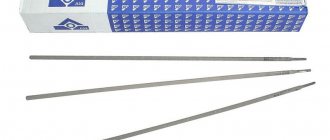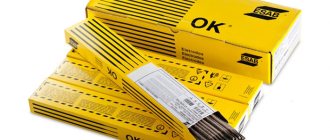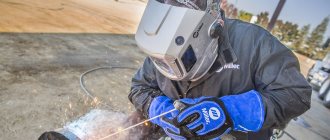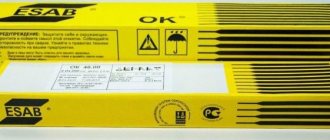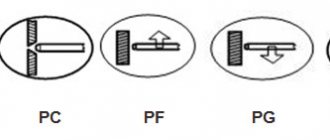To create one-piece structures from carbon and low-alloy steels, E50A electrodes are used. Products are manufactured in accordance with the GOST 9467 standard, adopted in 1975, and allow us to obtain seams with increased strength characteristics. The outer surface of the metal rods is coated to prevent oxidation and saturation of the metal melt with harmful impurities.
E50A electrodes are used for welding durable structures.
Explanation of the name
First, we need a transcript of SSSI 13/55. This will allow us to further consider the operating features of such electrodes and what they can provide. This abbreviation is deciphered as follows:
- U - universal;
- O - coating;
- N - scientific;
- I - institute;
This is a development of the domestic welding institute, whose name and number are fixed in the designation. Sometimes another letter I is added to the abbreviation, which denotes a research institute. By the way, UONII is the correct name according to GOST, but on the package there may also be UONI 13/55.
Decoding the abbreviation
The abbreviation E50A means:
- E – tool code indicating that it belongs to the category of electrodes for manual arc welding;
- 50 – minimum tensile strength of the seam, indicated in kg/mm² (the parameter is used when calculating loads on a welded structure);
- A – designation of the increased value of ductility and toughness of the metal deposited along the joint line of the parts.
E50A electrodes are used for manual arc welding.
Technical specifications
Welding electrodes UONI 13/55, the characteristics of which are discussed in this section, have the following important parameters:
- Coverage - basic;
- Surfacing coefficient - 9.5 g/a*h;
- Device productivity - 1.4 kg per hour;
- Consumption per kilogram of deposited metal is 1.7 kg;
- Tensile strength - 540 MPa;
- Yield strength - 410 MPa;
- Relative elongation - 29%;
- Impact strength of SSSI is 260 J/cm2.
These parameters are basic. It should also be said that the chemical composition of these electrodes is quite complex, including 0.09% carbon, 0.42% silicon and 0.83% manganese. On the manufacturer's website you can also find out the options for diameters and current strength for different spatial positions of the electrode.
Specifications
Today, there are a lot of different materials on the market for welding accessories. Electrodes of the UONI 13/55 brand have gained the most popularity, the technical characteristics of which allow welding work to be carried out in poor climatic conditions, where work with conventional tools is impossible.
UONI electrodes have been used for a long time in production and home welding work; they have passed the necessary tests and are approved by GOST. When welding, the seam is obtained with the required impact strength and is plastic under load. The technical specifications include a base coating that primarily interacts with the metal. Welding with UONI electrodes creates a high-quality seam on which even microscopic cracks are not detected.
Features of use
There are some nuances associated with the use of such devices in welding. Let's look at some of them:
- For welding it is necessary to use reverse polarity current;
- The coating is special, consisting of carbonates and fluoride formations, due to which the seams do not have gases and other harmful impurities;
- Low carbon steel contributes to significant weld durability;
- The absence of organic compounds prevents the formation of moisture on devices;
- In the manufacture of electrodes, the formation of various irregularities, cracks and other defects is completely eliminated.
The result is a strong seam that is not subject to aging and loss of properties when temperature conditions change. It is necessary to control the cleanliness of the connections, because the appearance of rust or oils leads to the formation of pores, and the connection will ultimately turn out bad.
Features of application
Each of the melting elements has its own niche of application; USI electrodes are used with the following parameters:
- The welding process occurs using reverse polarity current; the process is required by GOST.
- The seam eliminates the presence of gases and excess impurities by using a special coating of fluoride formations and various carbonates.
- The metal of the rod is used from low carbon steel compounds, which contributes to the reliability of the weld.
- Thanks to organic compounds, welding electrodes UONI 13/55 have low susceptibility to moisture.
- The design, made of low-alloy materials, avoids cracks and irregularities during the welding process.
Welding using UONI electrodes
The seam is not subject to aging or loss of fastening properties when exposed to temperature. Welding with UUNI electrodes should exclude the use of poorly cleaned materials, as they may be subject to corrosion in the future. The process occurs with a short arc, which avoids loss of connection quality. The main advantage over competitors is the result with the required hydrogen concentration, a connection resistant to the appearance of microcracks.
The chemical composition of materials and technology of use may vary depending on the manufacturer. Before purchasing, you need to inquire about compliance with the requirements and standards according to GOST, or the availability of a certificate of certification of welding materials.
Application of electrode welding in construction
Calcination procedure for welding electrodes UONI 13/55
To reduce the concentration of moisture and other unnecessary compounds in the coating - calcination by keeping it in an induction furnace. Each manufacturer of UONI 13/55 electrodes includes instructions for use and calcination of materials in the packaging. Neglecting the instructions is strictly prohibited, as this will result in a poor-quality connection.
Electrode welding principle
In situations where the instructions are not included or are damaged, it is necessary to follow the basic sequence of steps for calcination:
- The procedure is carried out immediately before use in the welding process. These actions are necessary for a high-quality result, a reliable seam and a stable burning of the welding arc.
- The maximum effect of calcination is 8 hours; if, after a specified period, the materials have not been used, the procedure is repeated again.
- The calcination time should not exceed four hours, and the permissible number of calcinations of the same UUSNI electrode is 3 times.
- The process uses a furnace heated to 250-280 degrees; for a uniform result, special molds are used, only then the melting elements are effectively calcined.
Storage conditions
Obtaining a high-quality result depends on the duration and storage conditions of the materials. Storage takes place in rooms with relative humidity up to 50%, without interacting with direct sunlight, air temperature of at least 12 degrees. Subject to all rules, standards and storage conditions of GOST 9466-75, the shelf life of materials can be unlimited.
Download GOST 9466-75
Electrode storage
Storage conditions and manufacturers
In order for products to retain their basic properties , they must be stored in appropriate premises. The relative humidity in the warehouse should always be at 50%, and the temperature should not exceed 14 degrees, which is achieved by using air conditioners. If the conditions are met, then the shelf life has no limitation.
The production of welding devices is carried out by such companies as LEZ, Spetselektrod, SZSM, Monolit. When purchasing, you must have a certificate of compliance with their standards. They are issued by the relevant authority.
Popular brands of electrical conductors and their features
The E50A family of electrodes includes:
- UONI-13/55, round section with dimensions from 2 to 5 mm (in increments of 1 mm). Designed for direct current supply and any welding technology (except vertical with the tool moving from top to bottom).
- UONI-13/55T, characterized by a reduced number of diameter variations (from 3 to 5 mm in 1 mm increments) and allowing operation with an alternating current supply.
- UONI-13/55G, available in sizes 3 and 4 mm and designed for constant voltage.
- OZS-28 (from 3 to 5 mm), allowing switching to direct and alternating current equipment, is the only type that has no restrictions on the direction of movement of the tool.
- OZS-33, which differs from OZS-28 by the impossibility of welding in a vertical position when feeding the electrode from top to bottom.
- OZS-18, designed for constant voltage and used in welding low-alloy steels that are resistant to corrosion under the influence of precipitation (for example, 10KhNDP).
- OZS-25, intended for welding structures made of carbon or low-alloy steels operated at ambient temperatures down to -40°C. Electrodes OZS-18 and OZS-25 do not allow the tool to be fed vertically from top to bottom.
- Russian industry offers products of the OZS-29 brand, characterized by increased cold resistance of the seam (up to -60°C), used for welding metal structures working in the open air in the conditions of the Far North.
- TMU-21A for welding pipelines with direct current.
- TsU-5 with a diameter of 2.5 mm for joining heat-resistant steels (temperatures up to 400°C).
Calcination of electrodes
Each package must contain a quality certificate and instructions detailing the calcination procedure. If the instructions are not followed, both the quality of the welded products and the quality characteristics of the resulting seam will deteriorate. The calcination procedure must be carried out before using such devices. If they have not been used for 8 hours, then the calcination is repeated again. The same electrode must be processed no more than 3 times , and the total amount of time should not exceed 4 hours.
For high-quality calcination, such devices must first be placed in special boxes and only then in an oven . The operating temperature range of calcination furnaces is from 200 to 300 degrees. Only compliance with the specified conditions will make it possible to make the welding products work for a long time and prevent the formation of various defects during calcination.
We examined UONI 13/55 electrodes. An important feature of their use is calcination . It will allow the welding electrode to work for quite a long time and avoid problems with various defects. When purchasing such devices, it is necessary to have certificates indicating compliance with standards and technical specifications. Take good care of the electrodes and they will last a long time. Good luck with your purchase of welding devices!
Quality certification
Electrodes intended for industrial use or for connecting critical structures are subject to mandatory certification.
Electrodes are subject to mandatory certification.
An official document on the territory of the Russian Federation is issued by the National Welding Control Agency (NAKS) to tool manufacturers and has a limited validity period (3 years).
Each certificate form has an individual number entered into the database and is certified by the signature of the NAKS President and seal.
The document states:
- type of certification (primary or periodic);
- brand and diameter of electrodes;
- testing methods and additional information.
When issuing a certificate, the controlling body receives a test batch of electrodes and carries out welding work followed by destructive testing of the seam. The results obtained confirm the product’s compliance with the standards; if the parameters deviate, a certificate is not issued. The presence of a certificate allows the use of electrodes for welding critical structures, but in the event of damage to the seam due to insufficient strength of the weld metal, the manufacturer bears financial and criminal liability in accordance with the legislation of the Russian Federation.
We recommend reading How graphite electrodes are used
